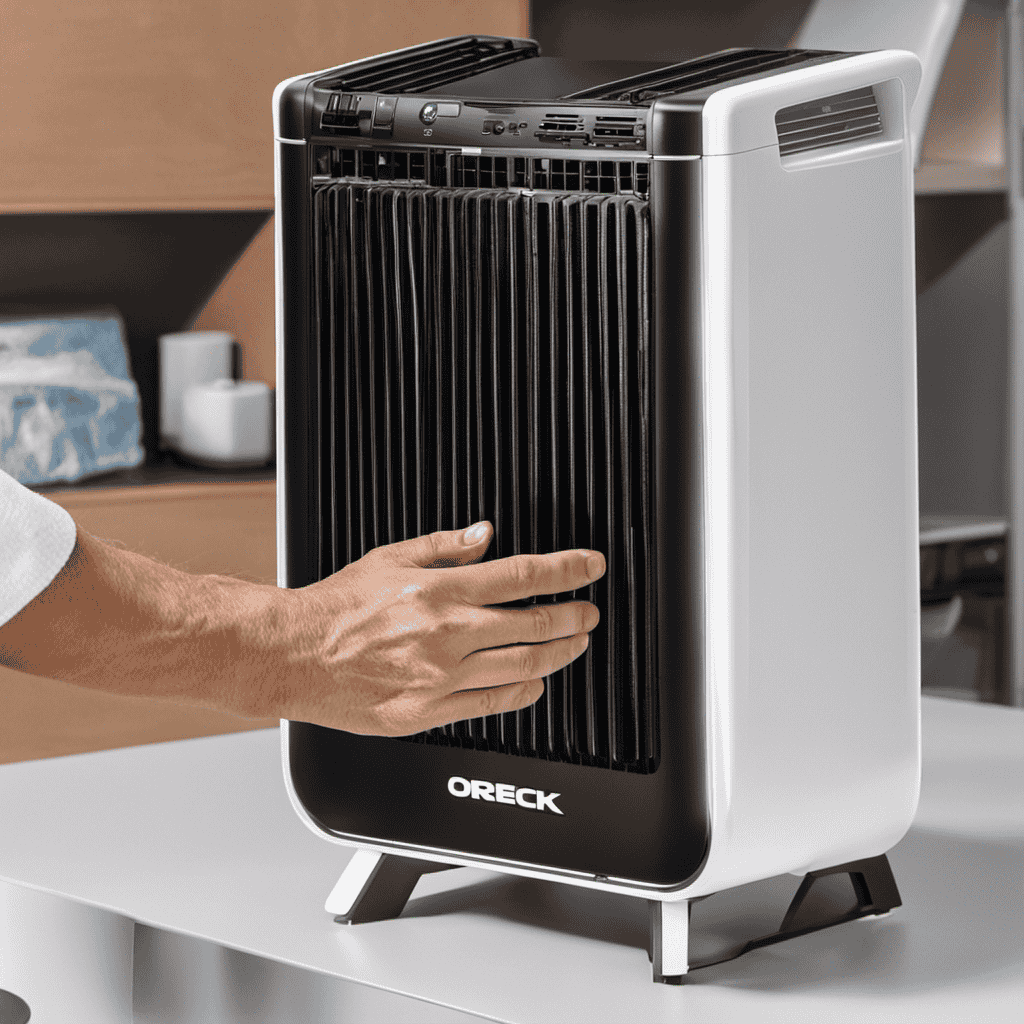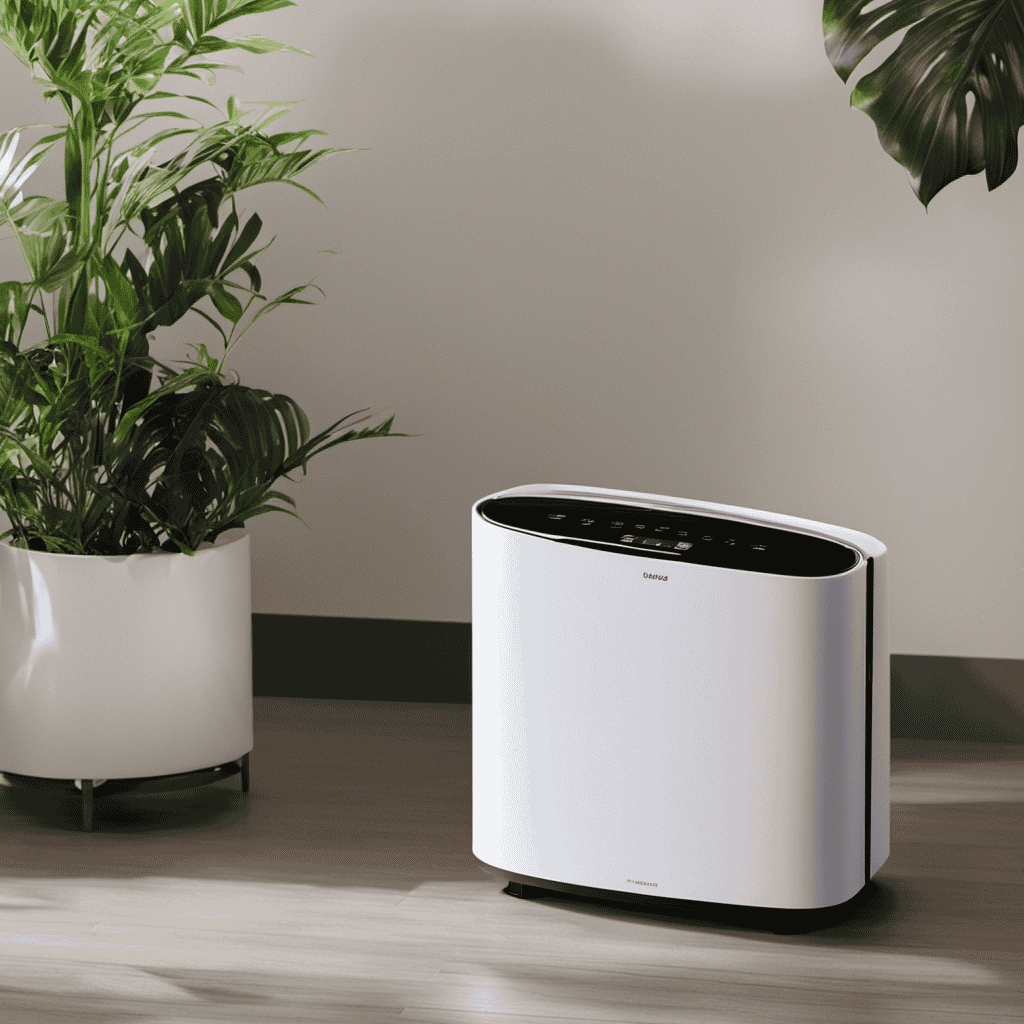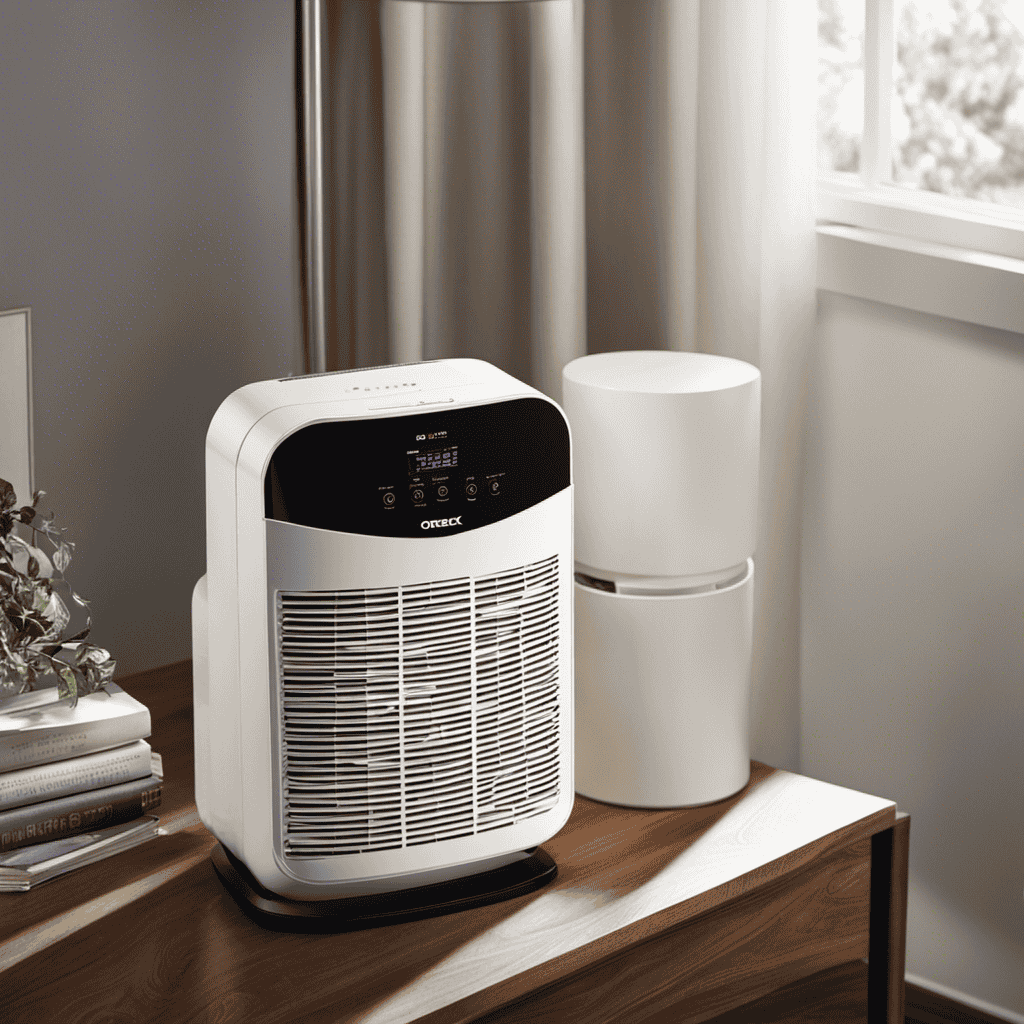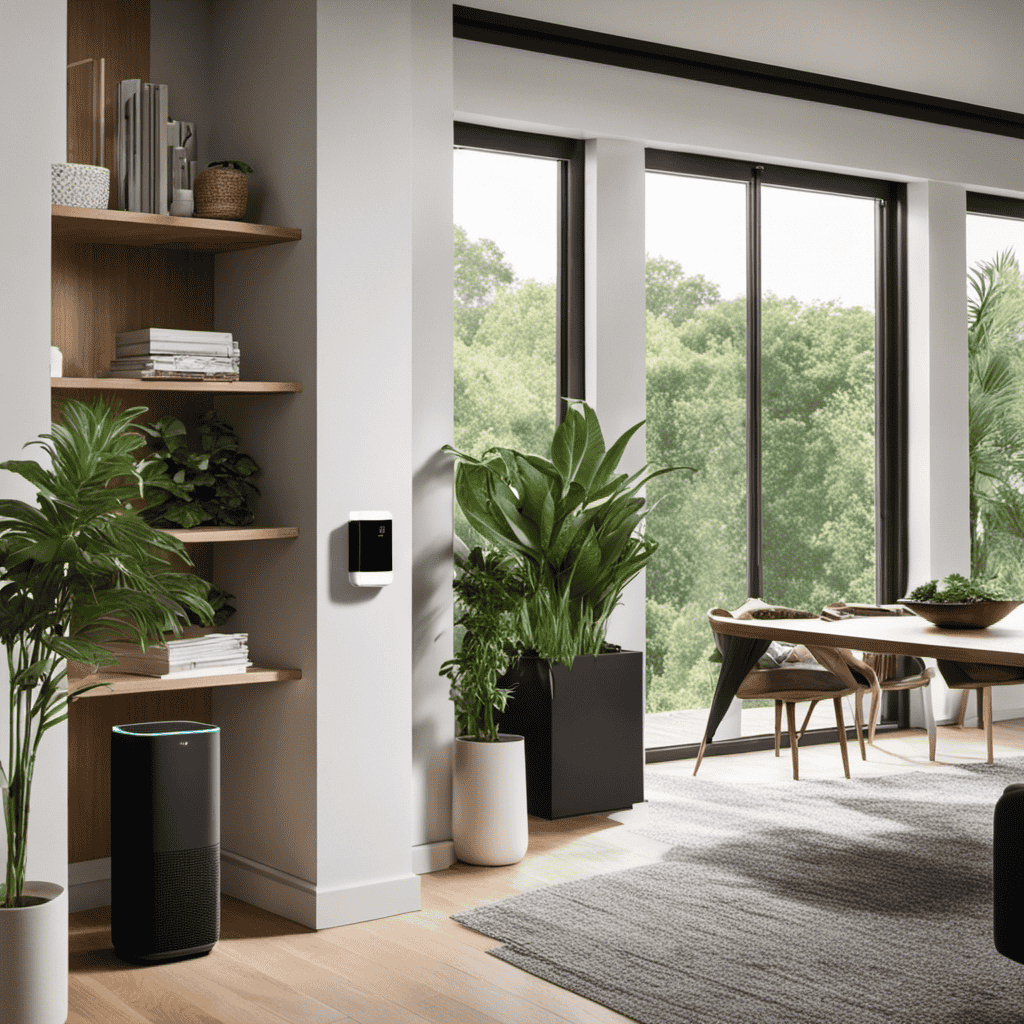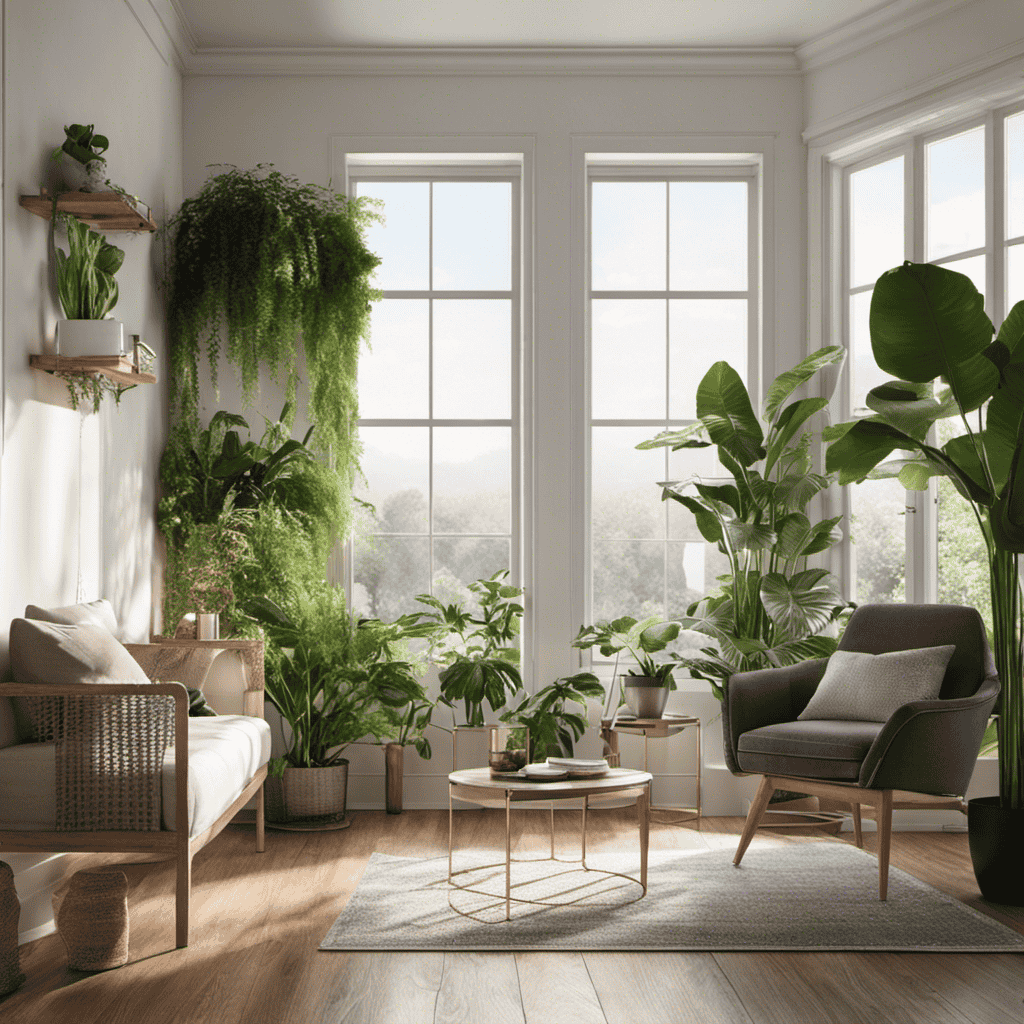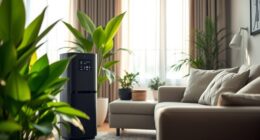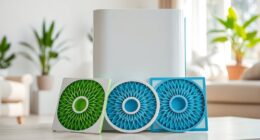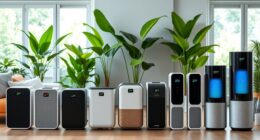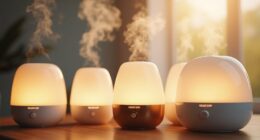I’ll show you how to clean the Oreck Airpcb Air Purifier, step by step. It’s important to keep your air purifier clean to ensure it functions at its best.
By following these instructions, you’ll be able to remove and clean the filters, as well as clean the exterior of the purifier. Don’t worry, it’s not as complicated as it sounds.
Let’s get started and have your air purifier looking and working like new in no time.
Key Takeaways
- Regularly clean the pre-filter and Truman Cell to remove dust and particles.
- Troubleshoot common issues using the user manual.
- Gather the necessary cleaning supplies, including a microfiber cloth, vacuum cleaner with brush attachment, compressed air canister, mild detergent diluted in water, and water spray bottle.
- Take necessary safety precautions by turning off and unplugging the air purifier before cleaning and proper storage after cleaning.
Understanding the Oreck Airpcb Air Purifier
To understand the Oreck Airpcb Air Purifier, you need to read the user manual. The manual provides comprehensive information on how to properly maintain and troubleshoot the device.
Regular maintenance is essential to ensure the optimal performance of the air purifier. It is recommended to clean the pre-filter and Truman Cell regularly to remove dust and particles. The pre-filter can be vacuumed or washed with warm soapy water, while the Truman Cell can be washed with water and mild detergent.
Additionally, the manual provides troubleshooting steps for common issues such as a blinking light indicator or a decrease in airflow.
Gathering the Necessary Cleaning Supplies
First, you’ll need to gather all the supplies you’ll need to clean your Oreck air purifier. To ensure effective cleaning, it’s important to have the right cleaning supplies. Here’s a checklist of the items you’ll need:
-
Microfiber cloth: This soft cloth is ideal for wiping down the exterior of the purifier and removing dust and dirt.
-
Vacuum cleaner with brush attachment: Use this to remove any loose debris from the air intake vents.
-
Compressed air canister: This will help you blow out any stubborn dust particles from the vents and filters.
-
Mild detergent: Dilute a small amount of detergent in water to clean the plastic parts of the purifier.
-
Water spray bottle: Fill this with clean water to rinse off any soap residue.
Remember to unplug your purifier before cleaning and avoid using harsh chemicals or abrasive materials.
Following these tips for effective cleaning will keep your Oreck air purifier in top-notch condition.
Turning Off and Unplugging the Air Purifier
Before diving into the cleaning process, it’s crucial to take the necessary safety precautions when unplugging your Oreck Air Purifier. This includes making sure the unit is turned off and unplugging it from the power source to avoid any electrical accidents.
Once unplugged, it’s important to properly store the air purifier after cleaning to prevent any damage or dust accumulation.
Safety Precautions When Unplugging
Make sure you’re careful when unplugging the Oreck AirPCB air purifier. Unplugging electronic devices can pose certain risks if not done properly.
To ensure your safety, it is essential to follow some precautions and practice safe unplugging practices.
First and foremost, always make sure to turn off the air purifier before unplugging it. This prevents any potential electrical shock or damage to the device.
Secondly, never pull the plug out by its cord as it can cause fraying or damage. Instead, firmly grasp the plug and pull it straight out of the outlet.
Lastly, avoid unplugging the air purifier with wet hands or in wet conditions, as this increases the risk of electric shock.
Importance of Turning off
To ensure your safety, it’s crucial that you always remember to turn off the device before unplugging it. This step is essential to prevent any electrical accidents or damage to the air purifier.
Apart from safety concerns, regularly turning off the air purifier also plays a significant role in its proper maintenance. By turning off the device, you allow it to cool down before cleaning, reducing the risk of burns or injuries. Additionally, it’s important to turn off the air purifier to conserve energy and extend the lifespan of the device.
Proper Storage After Cleaning
After you’ve finished cleaning, it’s important to store the device properly to maintain its functionality. Here are some proper storage tips to prevent dust buildup:
-
Cover the device: Use a dust cover or a clean cloth to protect the air purifier from dust and other particles when not in use.
-
Keep in a dry area: Moisture can damage the internal components of the air purifier. Store it in a dry area to prevent any potential water damage.
-
Avoid direct sunlight: Direct sunlight can cause discoloration and damage to the device’s exterior. Store it in a shaded area to protect it from harsh UV rays.
Properly storing your air purifier will help ensure its longevity and efficiency. By following these tips, you can prevent dust buildup and maintain a clean and healthy indoor environment.
Removing and Cleaning the Pre-Filter
First, you’ll need to unplug the Oreck airpcb air purifier before removing and cleaning the pre-filter.
Proper pre filter maintenance is essential for optimal performance and longevity of your air purifier.
To remove the pre-filter, locate the tabs on the sides of the unit and gently pull them towards you. Once the pre-filter is removed, inspect it for any visible dirt or debris. If it appears dirty, it’s time for a replacement.
Oreck recommends replacing the pre-filter every 3-6 months to ensure efficient air purification.
To clean the pre-filter, simply rinse it under running water until the water runs clear. Allow it to air dry completely before reinstalling.
With the pre-filter properly maintained, you can now move on to cleaning the HEPA filter for even better air quality.
Cleaning the HEPA Filter
Now, you’ll want to inspect the HEPA filter for any visible dirt or debris to ensure optimal air quality in your Oreck air purifier. The HEPA filter plays a crucial role in trapping airborne particles, allergens, and pollutants, so it’s important to keep it clean.
Here’s how to clean the HEPA filter:
- Remove the HEPA filter from the air purifier.
- Gently vacuum the filter using a soft brush attachment to remove surface dust.
- If the filter is heavily soiled, rinse it with lukewarm water. Avoid using hot water or harsh cleaning agents.
- Allow the filter to air dry completely before reinstalling it.
- Consider replacing the HEPA filter every 6-12 months to maintain optimal air purification performance.
Regularly cleaning and replacing the HEPA filter not only ensures cleaner air but also helps prolong the lifespan of your Oreck air purifier.
Enjoy the benefits of clean air in your home or office with a properly maintained HEPA filter.
Cleaning the Carbon Filter
When it comes to maintaining the filters in your air purifier, there are a few key points to keep in mind.
First, it’s important to regularly clean and maintain the filters to ensure optimal performance and air quality.
Second, the frequency of cleaning will depend on factors such as the level of air pollution in your area and the usage of the air purifier.
Lastly, to ensure the best cleaning practices, it is recommended to follow the manufacturer’s instructions and guidelines for cleaning the filters.
Filter Maintenance Tips
To keep your Oreck air purifier running efficiently, make sure you regularly clean and replace the filters. The filters play a crucial role in capturing and removing airborne particles, allergens, and odors from your indoor air.
Here are some filter maintenance tips to help you maximize the performance of your air purifier:
-
Filter Replacement:
-
Check the user manual for the recommended filter replacement schedule.
-
Purchase genuine Oreck replacement filters to ensure optimal performance.
-
Follow the manufacturer’s instructions for proper installation of the new filters.
-
Troubleshooting Tips:
-
If you notice a decrease in air purifier performance, check the filters for excessive dirt or damage.
-
Clean reusable filters according to the manufacturer’s instructions.
-
If the air purifier still doesn’t work properly after cleaning or replacing the filters, contact Oreck customer support for further assistance.
Cleaning Frequency Recommendations
It’s important to regularly clean and replace the filters in order to maintain the efficiency and effectiveness of your Oreck air purifier. Following a proper cleaning schedule is essential for optimal performance.
The frequency of cleaning depends on various factors such as the air quality in your environment and the usage of the purifier. As a general guideline, it is recommended to clean the pre-filter every 2-3 months and replace it every 6-12 months. The carbon filter should be replaced every 3-6 months, while the HEPA filter should be replaced every 12-18 months.
Regular cleaning ensures that the filters are free from dust, allergens, and other particles, allowing the purifier to work at its best and provide you with clean and fresh air. By maintaining a consistent cleaning schedule, you can enjoy the long-lasting benefits of improved air quality and a healthier living environment.
Best Cleaning Practices
Regularly maintaining and replacing the filters in your Oreck air purifier is crucial for optimal performance and improved air quality. To ensure the best cleaning practices, follow these steps:
-
Use a soft, dry cloth to wipe down the exterior of the air purifier regularly.
-
Every 1-3 months, depending on usage, clean the pre-filter by gently vacuuming or rinsing it with water and mild soap. Allow it to dry completely before reinserting.
-
Replace the HEPA filter every 6-12 months, or when the filter indicator light turns on. Remove the old filter and insert the new one, making sure it fits securely.
-
Use only recommended cleaning products, such as Oreck’s Air Purifier Cleaner, to clean the inner components of the air purifier.
-
Avoid using harsh chemicals or abrasive materials that could damage the purifier.
Cleaning the Ionizer Plates
Cleaning the ionizer plates is an essential step in maintaining the Oreck airpcb air purifier. These plates are responsible for attracting and trapping airborne particles, keeping the air in your home clean and fresh. Over time, the ionizer plates can become dirty and covered in dust and debris, reducing their effectiveness. To clean the ionizer plates, follow these simple steps:
- Turn off the air purifier and unplug it from the power source.
- Remove the front panel to access the ionizer plates.
- Gently brush off any visible dust or debris using a soft brush or cloth.
- Fill a basin with warm water and a mild detergent.
- Submerge the ionizer plates in the soapy water and let them soak for a few minutes.
- Use a soft brush or cloth to scrub the plates gently.
- Rinse the plates thoroughly with clean water and let them air dry completely before reassembling the air purifier.
By regularly cleaning the ionizer plates, you can ensure optimal performance and longevity of your Oreck air purifier. If you encounter any issues or have further questions, refer to the troubleshooting tips provided in the table below:
| Problem | Solution |
|---|---|
| Lack of airflow | Check and clean the air intake and filters. |
| Strange odor | Replace the filters and clean the ionizer plates. |
| Loud noise | Check for loose parts and tighten or replace as necessary. |
Remember to always refer to the user manual for specific cleaning techniques and troubleshooting tips for your model of Oreck air purifier.
Cleaning the Exterior of the Air Purifier
To maintain the performance and appearance of your Oreck air purifier, make sure to regularly wipe down the exterior using a soft cloth. Cleaning the exterior of your air purifier is essential to remove dust, dirt, and other contaminants that may accumulate over time.
Here are some cleaning techniques and recommended products to effectively clean the exterior of your Oreck air purifier:
- Use a soft, lint-free cloth to wipe down the exterior surfaces.
- For stubborn stains or dirt, dampen the cloth with mild soapy water and gently clean the affected areas.
- Avoid using harsh chemicals, abrasive cleaners, or solvents as they may damage the finish of the air purifier.
By following these cleaning techniques and using the recommended cleaning products, you can ensure that your Oreck air purifier remains in top condition.
Now, let’s move on to the next section on reassembling and testing the air purifier.
Reassembling and Testing the Air Purifier
Once you have finished wiping down the exterior, it’s time to reassemble and test your air purifier. Follow these reassembling tips to ensure everything is properly put back together. First, refer to the user manual for specific instructions on how to reassemble each component. Use the table below as a reference to keep track of the parts and their placement.
| Component | Placement |
|---|---|
| Filters | Insert into designated slots |
| Pre-filter | Securely attach to the main unit |
| Fan | Align and attach to the motor |
| Front grille | Snap into place |
After reassembling, it’s crucial to conduct a thorough testing process to ensure the air purifier is functioning correctly. Turn on the unit and check if the fan is spinning properly. Listen for any unusual noises or vibrations. Also, make sure that the air purifier is effectively removing pollutants from the air by monitoring the air quality indicators or using a separate air quality monitor. If everything looks and sounds good, congratulations! Your air purifier is ready to purify the air in your space once again.
Frequently Asked Questions
Can I Use Soap and Water to Clean the Filters of the Oreck Airpcb Air Purifier?
Yes, soap and water can be used to clean the filters of the Oreck Airpcb Air Purifier. However, there are alternatives such as using a vacuum cleaner or compressed air to remove dust and debris.
How Often Should I Clean the Exterior of the Air Purifier?
I should clean the exterior of the Oreck Airpcb Air Purifier every few weeks to remove dust and debris. It’s important to maintain a clean surface to ensure optimal performance and longevity of the device.
Is It Safe to Use a Vacuum Cleaner to Clean the Pre-Filter?
Using a vacuum cleaner to clean the pre-filter of the Oreck Airpcb Air Purifier has its pros and cons. It can remove larger particles effectively, but may not be able to fully clean fine dust. Alternatives include using compressed air or a soft brush.
Can I Reuse the Carbon Filter After Cleaning It?
Yes, you can reuse the carbon filter after cleaning it. It is important to clean the carbon filter regularly to maintain its effectiveness in removing odors and chemicals from the air.
What Should I Do if the Air Purifier Doesn’t Turn on After Reassembling It?
If the air purifier doesn’t turn on after reassembling it, troubleshooting is necessary. Common issues with air purifiers include improper assembly or electrical problems. Check connections, ensure proper reassembly, and contact customer support if necessary.
Conclusion
In conclusion, cleaning the Oreck Airpcb Air Purifier is a simple and important task to maintain its optimal performance.
By following the step-by-step instructions provided, you can ensure that your air purifier remains efficient in eliminating airborne particles and improving indoor air quality.
Remember to gather the necessary cleaning supplies, turn off and unplug the device, and thoroughly clean each component, including the pre-filter, HEPA filter, carbon filter, and ionizer plates.
Finally, reassemble the air purifier and test it to enjoy fresh and clean air in your home.
